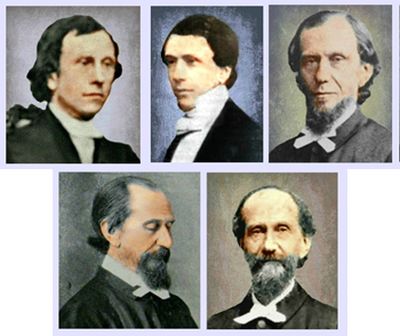 Stumbling upon a confronting quotation
Stumbling upon a confronting quotation
Several years ago now, while browsing through some books in a large bookstore in Cape Town, I came across Hermann Giliomee’s impressive tome titled The Afrikaners. As I was trying to balance it in the palm of one hand, it fell open to page 208, which gives a brief description of Andrew Murray’s preaching.
What immediately caught my eye was the quotation by Petronella van Heerden. As a young girl she had grown up in the Orange Free State (OFS) where her father was a landdrost (magistrate). But because there were no secondary schools for girls in the OFS in the 1870s, she had gone to pursue her studies in Andrew Murray’s pastorate of Wellington. She had later come into prominence when she graduated from Amsterdam University and returned to the Cape as the first Afrikaans-speaking woman to practice medicine.
Petronella recalls an unforgettable sermon by Andrew Murray
In the passage from Petronella’s memoir quoted by Giliomee, she recalls an unforgettable sermon that she had heard by Andrew Murray.
As an admirer of Murray’s devotional works, I found the excerpt somewhat confronting, because she portrays him as a preacher set upon scaring his listeners out of their wits in order to compel them to come into the Kingdom. She also describes his voice as being like that of a Muscovy Duck. One could say that this sermon was in the same vain as Jonathan Edwards’ Sinners in the hands of an angry God.”
As I read and reread the passage from her memoir, I could not reconcile her girlhood recollection with Andrew Murray’s insightful books on prayer and the Holy Spirit. Nor did her description accord with the effusive language of book titles and article headings associated with his life and work.
Andrew Murray: a pastor usually described in saintly terms
Those who knew Andrew Murray, or had researched his life and works, describe him as a humble man filled with love for God and neighbour.
Leona Choy, for example, coined one of her titles on Andrew Murray’s life: Apostle of Abiding Love (1978), while NL Cliff titled his 1967 article in The Life of Faith: St Andrew of South Africa. Even WM Douglas, writing in the mid-1920s, could not resist painting his old friend in saintly terms. The title and subtitle of his biography on Andrew Murray reads: Andrew Murray and His Message: One of God’s Choice Saints (1926).
Given the above-mentioned accolades, Petronella van Heerden’s recollections gave me pause for thought. In fact, I was so disturbed by what I had read that I hot-footed it to the National Library of South Africa where I proceeded to research Andrew Murray’s life.
I soon discovered that he had been suffering from a collapsed throat at the time of delivering his hell-fire sermon. It was this medical condition that had obviously given rise to his so-called Muscovy-Duck voice.
Be that as it may, this must nevertheless have been an unforgettable sermon because one of Andrew Murray’s daughters also recalls it. From her short comment, we know it took place on the evening of Ascension Day 1878 — the first evening set aside for 10 days of Pinkster (Pentecost) services held traditionally by the Cape Dutch Reformed Church.
According to her report, the church elders had requested Andrew Murray to preach on hell. She goes on to say: “Many a man and woman trembled under that sermon” (WM Douglas p 131).
 A voice as clear as a bell
A voice as clear as a bell
My research also uncovered another recollection associated with Andrew Murray’s preaching. It was penned by a young woman who had also attended the Huguenot Educational Seminary that Andrew Murray had established in 1874. Unfortunately, her name is not recorded. All we know of her is that she was a friend of the family who had later become a teacher at the Seminary. She had then gone on to become a missionary in the Sudan.
In her description of a missionary meeting she had attended at the Wesleyan Metropolitan Church in central Cape Town around 1910, she recalls how the voice of an aged and stooped Andrew Murray had reverberated through that church “as clear as a bell.” This is what she had to say:
A lady was sitting close to me, and as Dr Murray went up the pulpit steps, frail and grey and old, she asked, “Who is that old man? What a shame to make him go up those steps to preach.” I smiled inwardly and thought, “My dear lady, you will be surprised tonight.”
Dr Murray got up. He seemed to grow tall and majestic. In regard to the new work in the Sudan, he once more spoke according to the oracles of God. FORWARD! was his cry. Well my lady was surprised, and more than surprised. Pity gave way to reverence. “What a voice for such a body!” she exclaimed.
Clear as a bell, irresistible in its power and command, the all-victorious FORWARD! rang forth in tones which knew no hesitation or defeat. … So through that one word FORWARD!, Dr Andrew Murray was revealed to me, and I bowed my head and worshipped the God he served and loved. (WM Douglas pp 236-237).
A spiritual life marked by two distinct periods
Given the above description of the godly Andrew Murray at his spiritual peak, it is important that we not dismiss Petronella van Heerden’s childhood memory. For by Andrew Murray’s own admission, he describes his sermons during that period as “knowing the terror of the Lord, we persuade men” (WM Douglas p 57).
But the point to which I wish to draw your attention by juxtaposing his so-called Muscovy Duck voice with his bell-like one is that this contrast also mirrors two distinct before and after phases in his spiritual journey.
Of particular interest is the quotation by Ds (Rev) C Rabie below. Looking back on the ministry of Andrew Murray in Worcester in the early 1860s, he gives us a somewhat forthright description of Andrew’s dealings with members of his congregation there. He nevertheless qualifies this description with a statement concerning the change in Andrew Murray in later years. He says:
His pastoral visitation carried terror in the hearts of his parishioners. If his preaching was like thunderbolts from the summit of Sinai, what would personal rebuke be like? People felt under the earnestness of his individual dealing that they were being ground to powder. … I must add that there is a wide cleft between the stern Mr Murray of those days and the loving and gentle Mr Murray whom we knew in later years. (Johannes du Plessis pp 199-200)
 My project
My project
Besides uncovering the facts of Andrew Murray’s life, I became particularly interested in his spiritual journey, especially the “before” and “after” aspects spoken of by C Rabie. But instead of embarking on a non-fiction work, I decided to write a series of biographical novels on his life that focusses on his spiritual pilgrimage. My aim was, and still is, to try and reach a new Christian readership who might also be stirred to read his insightful works.
I have already completed two novels of my four-novel series on his life. They are titled: Andrew Murray: Destined to Serve and Andrew Murray: Destined to Win. They are now listed on the Revival Books site.
The third novel in the series will be titled: Andrew Murray: Destined to Wait and is due out in January 2019.
Learning from Andrew Murray’s spiritual pilgrimage
As you read Andrew Murray’s story, it will no doubt surprise you to learn about his spiritual struggles and the length of time it took for him to become victorious in the Christian faith. It was only in 1882, after the miraculous healing of his throat, that he felt he could at last share what he had learnt on his spiritual pilgrimage via his devotional writings. He was 54 at the time.
It goes without saying, that his story has been a great encouragement to me. I pray that it will be the same for you.
Olea Nel’s books on Andrew Murray can be ordered online:
South Africa’s Forgotten Revival
Andrew Murray: Destined to Serve
Andrew Murray: Destined to Win
References
Douglas, WM. Andrew Murray and his message. Fort Washington: Christian Literature Crusade, 1957.
Du Plessis, Johannes Christiaan. The life of Andrew Murray of South Africa. London: Marshall Brothers, 1919.
Olea Nel: Exploring the life and works of Andrew Murray http://www.oleanel.com







Lest we forget those who did the pioneering work for the spiritual life of the fledgling Christian community who had gathered from Europe, at and beyond the Cape of Storms that had become the Cape of Good Hope to many to this day. It is encouraging to learn that besides Dr. Peter Hammond, there are others who keep the memory and work of Andrew Murray alive.
I have the wonderful privilege of knowing Olea Nel and have seen her dedication over the years in introducing Andrew Murray to a generation who has been deprived of his teachings and influence in the history of South Africa. I was astonished about the fact that I’ve never heard about this passionate preacher and his writings, even though I’ve grown up in South Africa. Olea’s fist novel, “South African’s Forgotten Revival” has introduced me to an era in our history that was sadly swept under the carpet. Through her other published novels, she has brought Andrew Murray, the preacher and the man, back into our homes. Her rich and well researched descriptions of events in the form of a novel, is a true gift to the people of South Africa and beyond. Be sure not to miss her next novel due early 2019.
While writing on prayer and prophecy a few years ago I also really struggled to find just the dates of the Cape Awakening and it was then that I at last discovered Dr Olea’s magnificent, dedicated research. Understanding history gives us the context to understand the present. If so little was understood about Dr Murray, think how little a true prophet would have been understood in those days… Blessings!